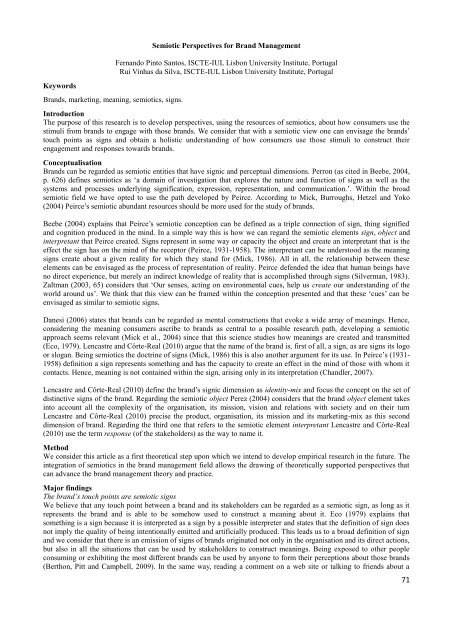Brand, Identity and Reputation: Exploring, Creating New Realities ...
Brand, Identity and Reputation: Exploring, Creating New Realities ...
Brand, Identity and Reputation: Exploring, Creating New Realities ...
Create successful ePaper yourself
Turn your PDF publications into a flip-book with our unique Google optimized e-Paper software.
Keywords<br />
<strong>Br<strong>and</strong></strong>s, marketing, meaning, semiotics, signs.<br />
Semiotic Perspectives for <strong>Br<strong>and</strong></strong> Management<br />
Fern<strong>and</strong>o Pinto Santos, ISCTE-IUL Lisbon University Institute, Portugal<br />
Rui Vinhas da Silva, ISCTE-IUL Lisbon University Institute, Portugal<br />
Introduction<br />
The purpose of this research is to develop perspectives, using the resources of semiotics, about how consumers use the<br />
stimuli from br<strong>and</strong>s to engage with those br<strong>and</strong>s. We consider that with a semiotic view one can envisage the br<strong>and</strong>s‘<br />
touch points as signs <strong>and</strong> obtain a holistic underst<strong>and</strong>ing of how consumers use those stimuli to construct their<br />
engagement <strong>and</strong> responses towards br<strong>and</strong>s.<br />
Conceptualisation<br />
<strong>Br<strong>and</strong></strong>s can be regarded as semiotic entities that have signic <strong>and</strong> perceptual dimensions. Perron (as cited in Beebe, 2004,<br />
p. 626) defines semiotics as ‗a domain of investigation that explores the nature <strong>and</strong> function of signs as well as the<br />
systems <strong>and</strong> processes underlying signification, expression, representation, <strong>and</strong> communication.‘. Within the broad<br />
semiotic field we have opted to use the path developed by Peirce. According to Mick, Burroughs, Hetzel <strong>and</strong> Yoko<br />
(2004) Peirce‘s semiotic abundant resources should be more used for the study of br<strong>and</strong>s.<br />
Beebe (2004) explains that Peirce‘s semiotic conception can be defined as a triple connection of sign, thing signified<br />
<strong>and</strong> cognition produced in the mind. In a simple way this is how we can regard the semiotic elements sign, object <strong>and</strong><br />
interpretant that Peirce created. Signs represent in some way or capacity the object <strong>and</strong> create an interpretant that is the<br />
effect the sign has on the mind of the receptor (Peirce, 1931-1958). The interpretant can be understood as the meaning<br />
signs create about a given reality for which they st<strong>and</strong> for (Mick, 1986). All in all, the relationship between these<br />
elements can be envisaged as the process of representation of reality. Peirce defended the idea that human beings have<br />
no direct experience, but merely an indirect knowledge of reality that is accomplished through signs (Silverman, 1983).<br />
Zaltman (2003, 65) considers that ‗Our senses, acting on environmental cues, help us create our underst<strong>and</strong>ing of the<br />
world around us‘. We think that this view can be framed within the conception presented <strong>and</strong> that these ‗cues‘ can be<br />
envisaged as similar to semiotic signs.<br />
Danesi (2006) states that br<strong>and</strong>s can be regarded as mental constructions that evoke a wide array of meanings. Hence,<br />
considering the meaning consumers ascribe to br<strong>and</strong>s as central to a possible research path, developing a semiotic<br />
approach seems relevant (Mick et al., 2004) since that this science studies how meanings are created <strong>and</strong> transmitted<br />
(Eco, 1979). Lencastre <strong>and</strong> Côrte-Real (2010) argue that the name of the br<strong>and</strong> is, first of all, a sign, as are signs its logo<br />
or slogan. Being semiotics the doctrine of signs (Mick, 1986) this is also another argument for its use. In Peirce‘s (1931-<br />
1958) definition a sign represents something <strong>and</strong> has the capacity to create an effect in the mind of those with whom it<br />
contacts. Hence, meaning is not contained within the sign, arising only in its interpretation (Ch<strong>and</strong>ler, 2007).<br />
Lencastre <strong>and</strong> Côrte-Real (2010) define the br<strong>and</strong>‘s signic dimension as identity-mix <strong>and</strong> focus the concept on the set of<br />
distinctive signs of the br<strong>and</strong>. Regarding the semiotic object Perez (2004) considers that the br<strong>and</strong> object element takes<br />
into account all the complexity of the organisation, its mission, vision <strong>and</strong> relations with society <strong>and</strong> on their turn<br />
Lencastre <strong>and</strong> Côrte-Real (2010) precise the product, organisation, its mission <strong>and</strong> its marketing-mix as this second<br />
dimension of br<strong>and</strong>. Regarding the third one that refers to the semiotic element interpretant Lencastre <strong>and</strong> Côrte-Real<br />
(2010) use the term response (of the stakeholders) as the way to name it.<br />
Method<br />
We consider this article as a first theoretical step upon which we intend to develop empirical research in the future. The<br />
integration of semiotics in the br<strong>and</strong> management field allows the drawing of theoretically supported perspectives that<br />
can advance the br<strong>and</strong> management theory <strong>and</strong> practice.<br />
Major findings<br />
The br<strong>and</strong>‘s touch points are semiotic signs<br />
We believe that any touch point between a br<strong>and</strong> <strong>and</strong> its stakeholders can be regarded as a semiotic sign, as long as it<br />
represents the br<strong>and</strong> <strong>and</strong> is able to be somehow used to construct a meaning about it. Eco (1979) explains that<br />
something is a sign because it is interpreted as a sign by a possible interpreter <strong>and</strong> states that the definition of sign does<br />
not imply the quality of being intentionally emitted <strong>and</strong> artificially produced. This leads us to a broad definition of sign<br />
<strong>and</strong> we consider that there is an emission of signs of br<strong>and</strong>s originated not only in the organisation <strong>and</strong> its direct actions,<br />
but also in all the situations that can be used by stakeholders to construct meanings. Being exposed to other people<br />
consuming or exhibiting the most different br<strong>and</strong>s can be used by anyone to form their perceptions about those br<strong>and</strong>s<br />
(Berthon, Pitt <strong>and</strong> Campbell, 2009). In the same way, reading a comment on a web site or talking to friends about a<br />
71
















